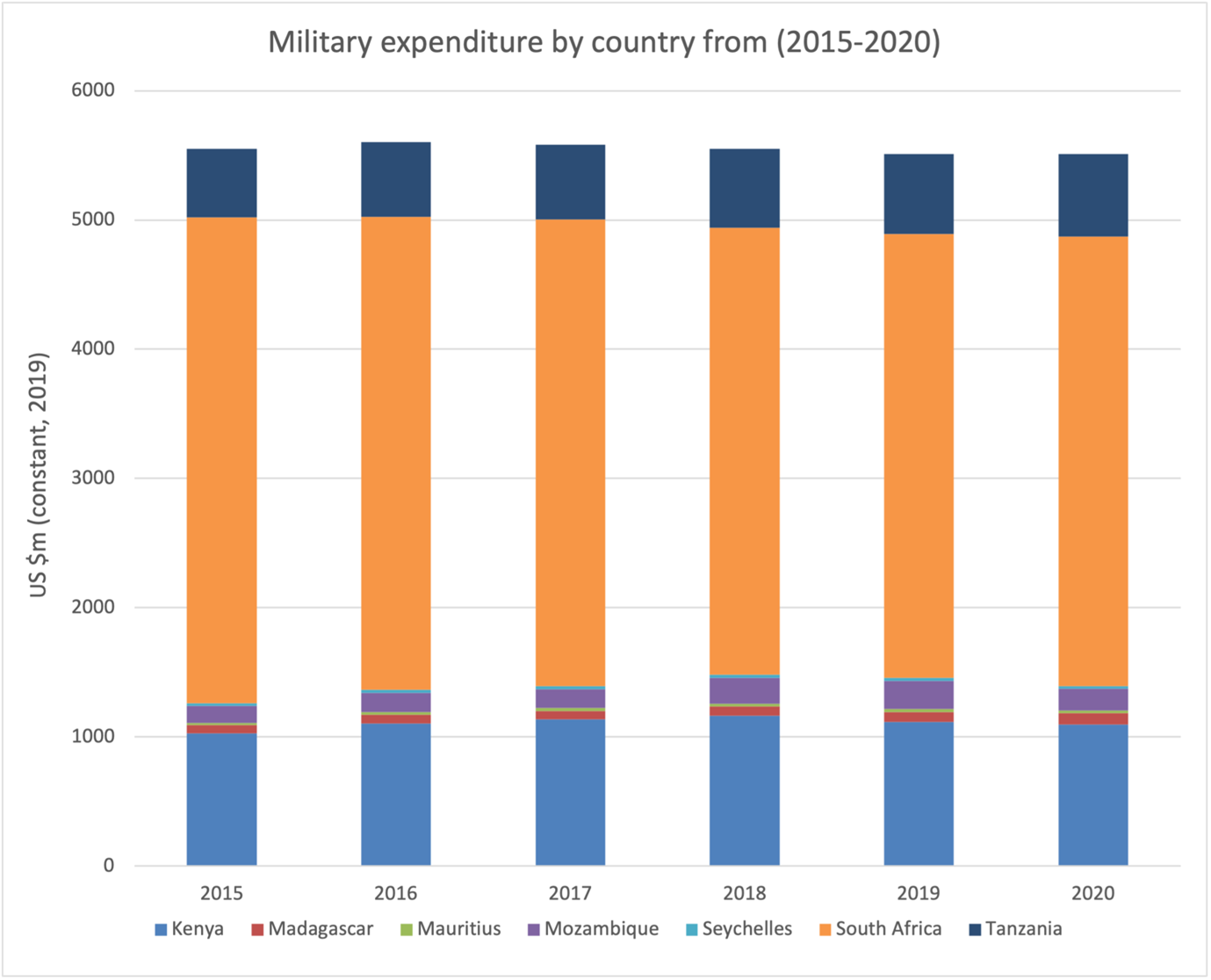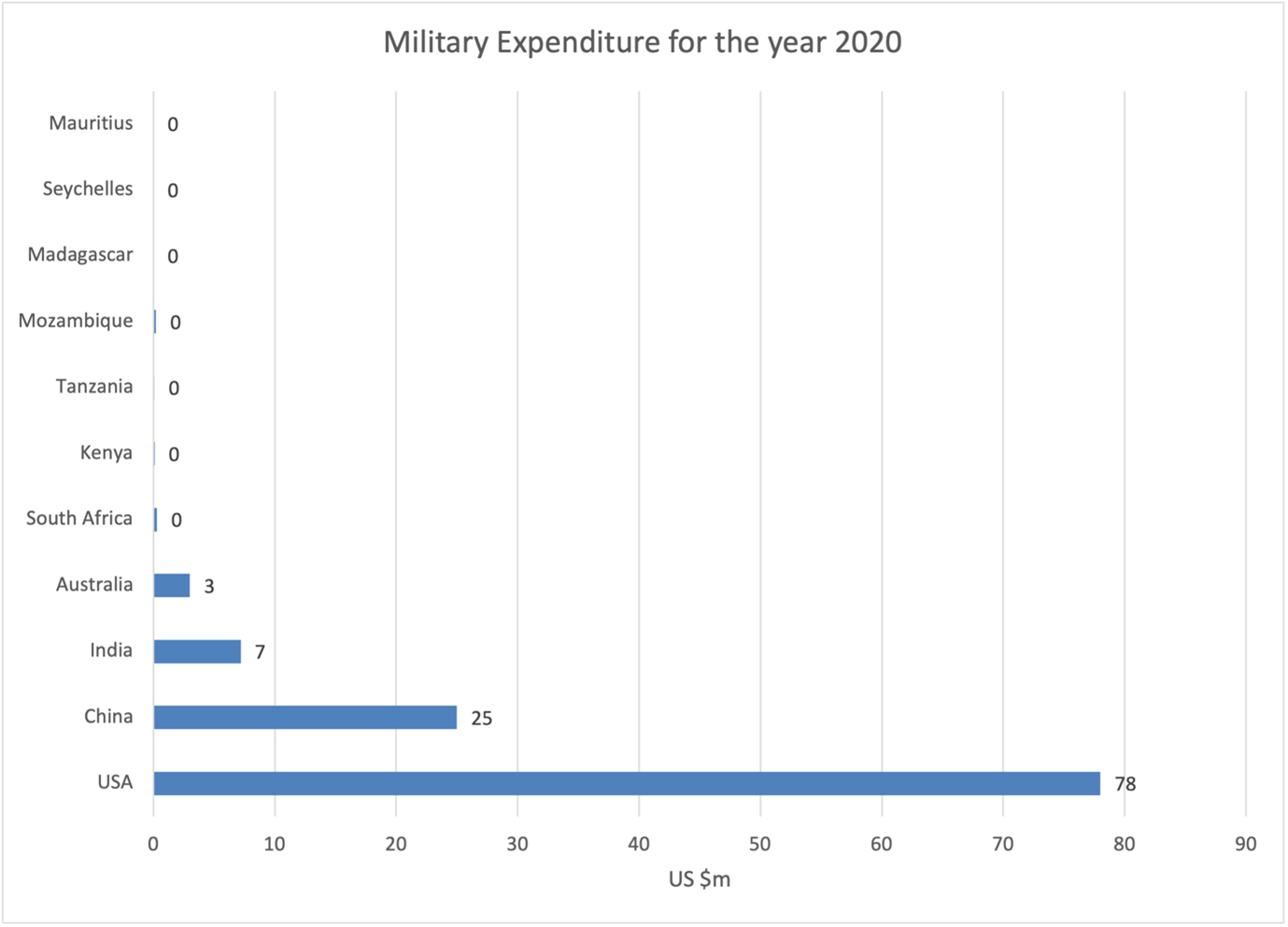Expanding the Indo-Pacific Region to East Africa by Faiza Samatar
27 June 2022
Introduction
The emergence of the term ‘Indo-Pacific’ has conjured up different visions of regional geographical expanses over the past decade. The geo-political region of the Indo-Pacific has been attributed to the area between the western United States and India, combining the Pacific Ocean and the eastern end of the Indian Ocean[1].
In recent years, the region’s political and economic importance has grown partly because of China and India’s economic growth and consequently the rise of their political and military strength. Increased global economic growth has also led to greater significance of the region as global trade has expanded along with the consumption of energy resources. Given that it harbours approximately two thirds of the world’s shipping containers and oil exports, a greater military presence in the area has also increased as countries seek to protect their maritime investments and shipments[2].This has led to the subsequent shift in how the region is viewed; from a geographical area to a more politically nuanced region as each country continuously increases its assertiveness in line with the growing importance of the region in world politics. A recent example of the continual focus on the Indo-Pacific region in global politics includes the latest G7 meeting which included statements from US President Joe Biden stating that the region’s continual freedom was essential to the future of global politics[3].
The Indian Ocean region states can be broadly divided into western and eastern sub-regional littorals, which can also capture their contrasting economic and military activities. The inclusion of East Africa as part of the Indo-Pacific depends on the foreign policy outlook of a particular country. Countries such as India and Japan consider East Africa as part of the Indo-Pacific which can be seen through their increased presence in the area dictated by initiatives such as the Asia-Africa Growth Corridor[4]. Australia and the United States don’t necessarily view the western border of the Indo-Pacific stretching all the way to East Africa as strongly as their Quad partners. It is important to note that China rejects the term ‘Indo-Pacific’ when regarding its policies and operations in Africa, preferring the term Asia-Pacific which reduces the influence of an open and free Indo-Pacific promoted by other countries in the region. Australia, despite acknowledging the inclusion of East Africa, does not have a comprehensive foreign policy that reflects the importance of the region to its Indo-Pacific strategy.
Expanding the Indo-Pacific region west to include East African countries warrants the transformation of foreign and defence policies of the greater powers in the Indo-Pacific. Through military expenditure analysis from 2015-2020, low levels of spending by East African-led militaries can be observed in comparison to the greater powers in the Indo-Pacific, and by contrasting South Africa, the largest spender in East Africa, to countries such as China, India and the United States. This reflects a less than capable regional military architecture, which requires foreign assistance to tackle most maritime security issues in the region. An examination of foreign military presence in the area also shows a growing level of foreign influence that possibly warrants the inclusion of East Africa into the Indo-Pacific strategies of select greater powers. This can only further enhance the security of East African littoral states which impacts the broader Indian Ocean Region and the greater Indo-Pacific.
Additionally, this inclusion will increase military partnerships resulting in opportunities of capital and technology investment for East African countries. Examples of this can be seen by China’s continual infrastructure investments such as building rail networks in Kenya, and the expansion of ports in Djibouti. Developed countries in the Indo-Pacific benefit from expanding their military interests through developing offshore bases which will protect their maritime trade corridors and the region hence fostering a peaceful environment that will potentially promote greater economic growth. The expansion west of the Indo-Pacific conceptualisation in the Australian foreign policy outlook will also be further examined.
Trends in East African defence spending
The recent defence spending of East African littoral states highlights the low level of capability in their militaries. In recent years, military expenditure has been stagnant in the region due to economic and political uncertainty, which poses a problem when comparing it to the major defence spenders in the Indo-Pacific region. Countries such as the United States, China, India and Australia spend significantly more than the largest defence spender of East African littoral states. This has led to the region’s military having a reduced influence due to their expenditure levels, which reflects a region less capable of providing its own security, hence the rise in foreign militaries tackling most maritime issues in the region.
Capturing the trends of defence spending in the region involves the analysis of ‘Military Expenditure by Country from the Year 2015-2020’ to provide the most current outlook of the region. The analysis of SIPRI data identifies contemporary defence spending in select East African states. Figure 1 shows that military expenditure for the region has not increased in recent years, with South Africa being the largest military spender among the countries listed in the region primarily due to its role as one of the largest economies in Africa[5]. This trend is further emphasised in the graph that contrasts East African countries with the military spending of larger economies.

Figure 1. Military expenditure by country, 2015-2020. Source: SIPRI Military Expenditure Database
The analysis of the South African economy as well as its defence trends is important, as it reflects the region’s changes in military expenditure due to its high proportion of spending among other East African countries. The stagnation in military expenditure in the region from the year 2015 resulted from low commodity and energy prices, which affected the South African economy greatly due to its heavy reliance on exporting commodities[6]. Inflation in the region in 2017 also led to a reduction in the defence budget[7]. Commodity prices improved in 2017 but South Africa saw reduced defence spending because of political uncertainty along with high personnel costs, which resulted in continual cuts to its defence budget[8].
A defence strategic plan published by the South African department of defence in 2020 highlighted that a stable economic environment was crucial to revive the defence industry and allow its export expansion into other African countries[9]. Through an advanced defence industry, South Africa wants to be recognised as a regional power, however this ambitious goal contrasts greatly to the ongoing budget cuts and the financial mismanagement of its state-owned company Denel[10]. Inadequate maintenance of equipment, a lack of troops and an unstable neighbourhood are all factors currently diminishing the military capability of South Africa as well as the lack of funds allocated to defence projects. The 2017/18 Defence Review highlighted similar problems regarding the ambitions of the military, and do not reflect the capabilities and the funding needed to achieve the outlined goals[11].
Heavy cuts to defence budgets were witnessed in 2020, as countries shifted military resources to declining sectors of the economy because of the COVID-19 pandemic. Figure 2 is included to compare military expenditure of the East African littoral countries to the biggest military spending countries present in the Indo-Pacific[12]. South Africa’s military expenditure which is the largest both among East African littoral states and the continent as a whole, appears miniscule in comparison to the amounts the United States, China, India, and Australia are spending to ensure the capability of their militaries.

Figure 2. Military expenditure, 2020. Source: SIPRI Military Expenditure Database
Foreign military presence
The previous analysis of defence spending trends has highlighted the East Africa’s stagnating military expenditure. This results in regional countries not being able to adequately tackle frequent maritime issues hence the rise in foreign military deployments in the region. An increase in foreign military presence contributes to a secure region that helps to further facilitate the inclusion of East Africa into the greater Indo-Pacific. Post 9/11 saw a huge influx of foreign military deployments into the Horn of Africa region, mainly into Djibouti and Somalia, so to engage in counterterrorism operations and to assist deployed Western troops in the Middle East. From 2005-2012, there was a further influx to combat rising piracy in the Red Sea which saw China launch its first military operation in the region in 2008.
Djibouti is the focal point of most military bases in the Horn of Africa region with seven countries having built operational facilities on land leased from the Djibouti government[13]. French operational military facilities and troops remained post-independence, leading to French forces in Djibouti being the largest permanent division of the French army. France also controls strategic points of Djibouti city such as the main international airport and a naval base which houses French nuclear submarines operating in the Indian Ocean[14]. Other countries with notable military bases in Djibouti include the United States, Japan and Italy.
China’s first strategic military outpost was opened in 2017 in Djibouti, which is capable of accommodating aircraft carriers, assault carriers and large warships[15].The base supports China’s engagements in anti-piracy missions, peacekeeping, and the protection of Chinese assets and evacuation of its citizens in times of crisis. The opening of this base in The Horn of Africa is seen as part of the integration of China’s maritime sea route, which contributes to its Belt and Road Initiative and has led to increased tensions with the US[16]. China also has other investment projects in Djibouti, with the main port adjacent to the base undergoing developments that would increase commercial use as well as allowing China to use it for its military interests. The growing Chinese military influence in the Indo-Pacific has led to India having agreement talks with Japan about access to its facilities in Djibouti along with additional talks with France and the US[17].
India’s involvement in the region is more focused on the IOR island states such as Seychelles, Madagascar, and Mauritius in attempts to develop its own military base in response to China’s base in Djibouti[18]. The island of Seychelles has been the main target of the Indian government’s vision of ‘security and growth for all in the region’ (SAGAR) including a number of remote unpopulated islands found in its territory. There was an agreement between the two governments in 2015 to establish a joint military facility on Assumption Island but due to great opposition from the public citing sovereignty issues, the plans fell through in 2018. Consequently, the administration in office at the time was removed due to great public opposition[19]. The Indian government confirmed its agreement with the government of Mauritius to establish military facilities on Agalega archipelago which will allow the Indian navy to conduct broader naval operations in the western Indian Ocean[20].
The growing influx of foreign powers in the region already highlights an interconnection between the greater Indo-Pacific region and East Africa. This is a positive outcome for increasing engagement between the broader Indo-Pacific and the East African region, as most of the foreign powers operating in East Africa have Indo-Pacific strategies. However, problems can arise when many countries, which all have different Indo-Pacific strategies, are competing for influence in the same region. East African littoral states stand much to gain from partnering with foreign powers given the high demand for crucial capital investments such as ports and the provision of maritime protection, however they should remain circumspect in choosing the right partners[21]. The recent influx of foreign powers shows that they first came to the region to engage in the maritime protection of shipping routes. However, with piracy rates continuing to fall, it might prove a challenge or perhaps an opportunity for foreign states to build greater economic and military partnerships rather than remaining in the region based on peace keeping missions alone.
Australian involvement in the East African littoral states
The growing importance of the East African region poses questions regarding the engagement of the Australian government, which has historically lacked a consistent strategic outlook and interest in the region[22]. This can be deduced from the notable absence of Africa from both its 2016 Defence White Paper and 2017 Foreign Policy White Paper, which focus mostly on Australia’s engagement with neighbouring Asian countries and Pacific Island nations. The most significant military engagement with the region was the deployment of two frigates in 2009 by the Royal Australian Navy to patrol through the Gulf of Aden into the Red Sea as part of ‘Northern Trident’, which was a global deployment of navies that engaged in a range of exercises to support the role of diplomacy in the region[23].
Australia’s economic engagement with East African countries is more established, with Australian companies investing in the natural resources sector and many companies having headquarters in Perth, Western Australia. It’s important to note the links between the state of Western Australia and East Africa, partly because of the Indian Ocean link and the continual investment of WA based mining companies into the region, given that they export over 52% of Australian goods to Africa[24]. A report published by the Advisory Group on Australia-Africa Relations noted that more than 200 ASX-listed companies operated more than 700 mining projects in the African continent[25]. This highlights the growing importance of the continent which further signifies the importance of Australia’s relation with East Africa and the overall inclusion of it in Australia’s conception of the Indo-Pacific region.
Australia’s inconsistent military and economic strategy with East Africa is in stark contrast to the comprehensive engagement strategies of some of its close allies. Through the analysis of the Quad member state’s relationships with the region, particularly that of Japan, provides an example that far outweighs Australia’s engagement with the region, given that they share similar Indo-Pacific strategies. Japan has deep engagement in peace and security operations with the African Union and regional organisations. This includes the continual expansion of the Japanese military base in Djibouti, as well as supporting UN Peace Keeping missions, thus emphasising its role to help advance African states in their ability to secure the Indo-Pacific. Economically, in 2016 the Japanese Government promised US$20billion in private investments to African entrepreneurs to help advance technology through innovation[26]. This will bolster economic growth particularly in important sectors such as Information and Technology which will lead to a greater positive outcomes for East Africa.
The Australian government’s strategic view of the region as predominantly an aid receiver, diminishes the IMF outlook of Africa being one of the greatest future economic growth areas. With close partners Japan and India concentrating on the East African littoral region due to their strategic understandings of the Indo-Pacific, Australia’s ongoing lack of engagement with the continent does not align with its partner’s broader regional economic and political interests[27]. Concentrating solely on the eastern half of the Indian Ocean can only lead to a loss in Australian economic and political opportunities in an expanded Indo-Pacific.
Conclusion
The western expansion of the Indo-Pacific to the shores of East Africa requires more contextual understanding of both the military capabilities and the external defence environment of the region. This policy brief has examined the growing importance of the relationship between the established Indo-Pacific powers and emerging East African littoral states. An analysis of current defence expenditure showed a stagnation in the level of spending by larger East African economies, which were affected by an energy and oil price crash in 2014. A lack of investment into the defence industry in East Africa has also led to a reduction in indigenous defence spending as countries look to more costly defence options abroad. The influx of greater foreign military presence in the past two decades in the Horn of Africa region is therefore partly a response to regional military deficiencies in tackling maritime issues such as piracy and illegal fishing.
The growth in external foreign militaries has an influence on the capabilities of national East African military and economic partnerships, as they transition from only maritime security and shipping protection to more comprehensive strategic, economic and political relationships. This presents a wealth of opportunities for major and middle powers to invest in the emerging defence infrastructure of East African countries. Examining the current position of the Australian government, however, highlights an inconsistent engagement with East Africa in terms of its military and economic policies. Given the importance of the Indo-Pacific strategy to Australian foreign policy, the increased engagement in East Africa by fellow Quad members and the inevitable future economic growth of the region, the current Australian strategy needs to become more encompassing. If it does not Australia will run the risk of reduced engagement with the greater Indo-Pacific region and missed opportunities to grow its international economic and strategic standing.
About the author
Faiza Samatar is a Research Analyst Intern in the Semester 2 2021 DSI Internship Program. She is currently studying an undergraduate economics major at the University of Western Australia. LinkedIn
Notes
[1] Rory Medcalf, “Indo-Pacific Visions: Giving Solidarity a Chance. Asia Policy,” 14(3), 79–96, https://doi.org/10.1353/asp.2019.0043.
[2] “Geopolitics and Geoeconomics in Europe and Asia,” International Political Science Association, 2021, accessed 12th October, 2021, https://www.ipsa.org/wc/panel/geopolitics-and-geoeconomics-europe-and-asia.
[3] Anthony Galloway, “Forget ‘Asia-Pacific’, it’s the Indo-Pacific we live in now. Where is that, exactly?,” Sydney Morning Herald (Syndey) 2021, https://www.smh.com.au/national/forget-asia-pacific-it-s-the-indo-pacific-we-live-in-now-where-is-that-exactly-20210810-p58hku.html.
[4] Takuya Taniguchi, “Should We Forget about the Asia-Africa Growth Corridor?,” Lettre du Centre Asie, no. 87 (2020), https://www.ifri.org/en/publications/editoriaux-de-lifri/lettre-centre-asie/should-we-forget-about-asia-africa-growth.
[5] “SIPRI Military Expenditure Database,” ed. SIPRI, SIPRI databases (Stockholm: SIPRI, 2021). Data for all countries 1949–2020 (excel spreadsheet).
[6] “Chapter Nine: Sub-Saharan Africa,” The Military Balance 117, no. 1 (2017), https://doi.org/10.1080/04597222.2017.1271216.
[7] “Chapter Nine: Sub-Saharan Africa.”; “Chapter Nine: Sub-Saharan Africa,” The Military Balance 118, no. 1 (2018), https://doi.org/10.1080/04597222.2018.1416986.
[8] “Chapter Nine: Sub-Saharan Africa.”
[9] “Department of defence strategic plan,” (March 2020).
[10] “Chapter Nine: Sub-Saharan Africa,” The Military Balance 119, no. 1 (2019), https://doi.org/10.1080/04597222.2019.1561035.
[11] “Chapter Nine: Sub-Saharan Africa,” The Military Balance 120, no. 1 (2020), https://doi.org/10.1080/04597222.2020.1707971.
[12] “SIPRI Military Expenditure Database.”
[13] David Brewster, “Base race in the Horn of Africa,” The Intepreter 2018, https://www.lowyinstitute.org/the-interpreter/base-race-horn-africa.
[14] Youssef Igrouane, “Djibouti: A Busy Hub of Foreign Military Bases on the Horn of Africa,” Inside Arabia 2019, https://insidearabia.com/djibouti-a-busy-hub-of-foreign-military-bases-on-the-horn-of-africa.
[15] Leighton G. Luke, “China Boosts Djibouti Presence: More Investments and Naval Base Capable of Docking Aircraft Carriers,” Future Directions International (2021), https://www.futuredirections.org.au/publication/china-boosts-djibouti-presence-more-investments-and-naval-base-capable-of-docking-aircraft-carriers.
[16] Karl Ragas, “Djibouti at a Crossroads: China’s African Engagement and an Adversarial Beijing-Washington Relationship,” (2021), https://www.futuredirections.org.au/publication/djibouti-at-a-crossroads-chinas-african-engagement-and-an-adversarial-beijing-washington-relationship.
[17] Neil Mevin, “Foreign Military Presence In Horn of Africa,” Stockholm International Peace Research Instititute (2019).
[18] “Department of defence strategic plan.”; Astha Chadha, “India and the Seychelles: Economics First, Defense Later,” The Diplomat, 2020, https://thediplomat.com/2020/12/india-and-the-seychelles-economics-first-defense-later.
[19] Vinitha Revi, “Seychelles and Assumption Island project: Another test for India,” Observer Research Foundation (2020), https://www.orfonline.org/expert-speak/seychelles-assumption-island-project-another-test-for-india-66551.
[20] Mevin, “Foreign Military Presence In Horn of Africa.”
[21] Gurjit Singh, “The Indo-Pacific Concept And Its Africa Connect ” Forbes Africa 2021.
[22] William Hicks and Dr Pichamon Yeophantong, “Why Africa Matters to Australia,” Australian Institute of International Affairs (2019), https://www.internationalaffairs.org.au/australianoutlook/why-africa-matters-australia.
[23] “Indo-Pacific Region,” CEOWORLD Magazine, accessed 12th October, 2021, https://ceoworld.biz/indo-pacific/; Anthony Bergin, “Australia and Africa working together,” Australian Strategic Policy Institute (2013), https://www.aspistrategist.org.au/australia-and-africa-working-together.
[24] Bergin, “Australia and Africa working together.”
[25] Advisory Group on Australia-Africa Relations, “A strategy for Australia’s engagement with Africa.”
[26] Brittany Morreale, “Japan deepens its engagement of Africa,” Asian Studies Association of Australia, 2016, http://asaa.asn.au/japan-deepens-its-engagement-of-africa.
[27] Hon. Richard Marles MP, “Address to The Perth USASIA Centre WA Indo-Pacific Defence Conference,” (Crown Casion, Perth, 2019).



